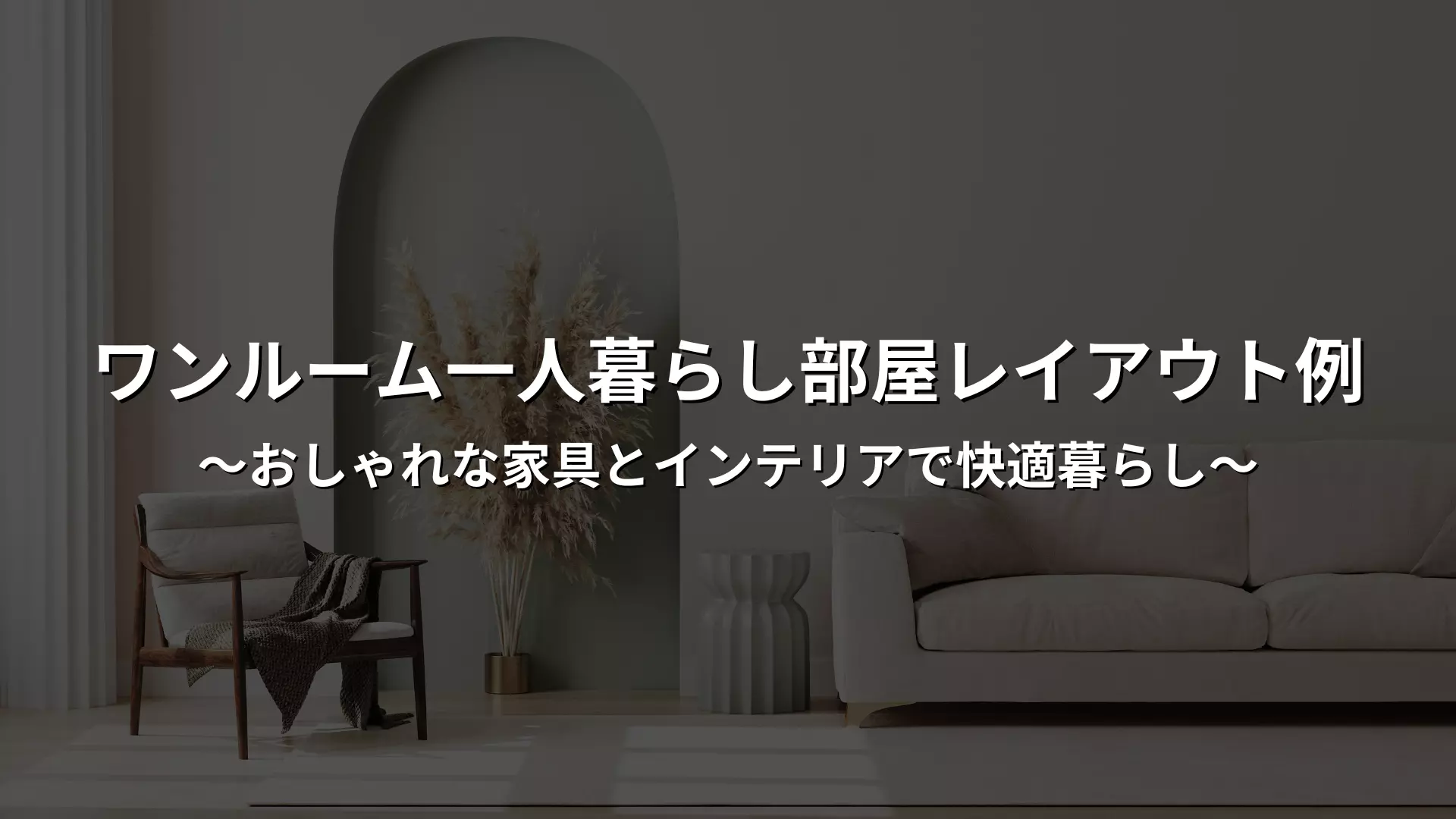Things you should know before thinking about room layout for single-person living
When you start living alone, the first thing you should think about is the layout of your room. The arrangement of your furniture and interior decor greatly affects how comfortable your space is and how it looks. The optimal layout pattern will vary depending on the size and shape of your room, and whether it's a studio or 1K apartment. Also, by considering the size and placement of your furniture, and the consistency of colors, you can create a comfortable and stylish space.
Here, we will explain the basic points you should keep in mind before thinking about the layout, as well as perspectives to improve livability.
Understand the size and layout of the room and think about the layout that suits your lifestyle
Before deciding on the layout of a room, the first thing you should do is accurately measure the dimensions and understand the floor plan. Measuring the width and depth of the room, ceiling height, and the position of windows and doors in advance will ensure that the placement of furniture and interior decor is not forced. In floor plans for single-person living, such as studios and one-room apartments, it is important to maintain a smooth flow of daily life.
For example, placing a bed near the entrance makes it easier to move around, but you may be concerned about people looking in from the entrance. In such cases, using a partition or rack as a divider can ensure privacy while maintaining a stylish impression. Consider the places and actions you frequently use in your daily life, and plan a layout that allows you to use the necessary furniture smoothly. By understanding the size and layout before deciding on the placement, you can reduce wasted space and create a comfortable and easy-to-use room.
Basic points for choosing and arranging furniture and interior
In order to achieve both comfort and style in a room for one person, it is important to choose and arrange furniture and interior items in a balanced way.
First, choose furniture that is appropriate for the size of the room and your lifestyle. Sofas and tables that are too large can feel oppressive, so we recommend simple rectangular or square designs or low-profile furniture. Using the same colors and materials for the interior will help the entire room come together.
For example, combining wood-grain furniture with white or gray fabrics creates a calm atmosphere. Furthermore, the shape and height of the table and chair legs also play a role in determining the impression. It is important to plan the layout so as not to interfere with daily life, and placing beds and storage against the wall and leaving a large central space will make it easier to move around.
In addition, by utilizing wall storage, open racks, and bookshelves, you can ensure storage capacity while also enhancing the interior design. By being conscious of how you select and arrange your furniture and interior, you can create a comfortable and attractive room even in a limited space.
Tips for creating a comfortable space in a one-room apartment
Since a one-room apartment contains all of your daily needs in one space, how you use the space is important to live comfortably. The first thing to keep in mind is zoning; gently dividing your sleeping, relaxing, and working areas with furniture, rugs, curtains, etc. will add structure to your life. Choosing low furniture will allow the eye to wander and make the room feel larger. The use of color is also key; using a consistent base color while adding accent colors with cushions and accessories will create a stylish atmosphere. For storage, make use of under the bed and on the walls, and hide items that tend to give off a sense of everyday life to create a neat and tidy space.
In addition, by skillfully incorporating potted plants and lighting, you can create a comfortable space. Even in a limited space, by combining the placement of furniture and interior, color usage, and storage ingenuity, you can achieve a comfortable and personalized lifestyle even in a one-room apartment.
Layout tips to make a one-room apartment look larger
Because a one-room apartment has limited space, it is necessary to make it appear larger through the arrangement of furniture and interior decor, as well as the use of colors. By leaving the center of the room open to ensure a clear flow of traffic, and by being creative with the height and arrangement of furniture, you can reduce the visual sense of oppression. Other effective ways to create a space include making use of walls and storage, introducing low-profile furniture, and coordinating colors.
Here, we will introduce specific ways to make a one-room apartment feel spacious and comfortable, from the positioning of large furniture such as beds, sofas, and tables, to how to display walls and storage, and color scheme tips.
How to reduce the feeling of oppression by changing the position of the bed, sofa, and table
The placement of large furniture is important to make a one-room apartment feel spacious.
Furniture such as beds, sofas, and tables should be placed as close to the walls as possible, and the center of the room should be kept wide open to make it easier to move around. It is especially important to place the bed in a position that does not block the line of sight, as large furniture that looms over the room when viewed from the entrance can create a feeling of oppression. Choosing a low sofa and a foldable or movable table with casters will allow you to flexibly change the layout depending on the purpose.
In addition, by leaving an appropriate amount of space between furniture, eyes can flow freely and the entire space feels larger. Even in a limited space, by arranging furniture in an appropriate way, you can create a comfortable living environment both visually and physically.
Make your space look neat and stylish by using storage furniture and wall space
Securing storage space can be a challenge in a one-room apartment, but you can make the room appear larger by choosing and arranging storage furniture properly.
First, choosing storage furniture that is low in height will open up the view and reduce the feeling of oppression. Open shelves, hanging shelves, cabinets, and chests that utilize wall space are excellent ways to increase storage capacity while saving floor space. Another key is to strike a good balance between visible and hidden storage, stylishly displaying books and miscellaneous items and storing everyday items that tend to show signs of everyday life in boxes or furniture with doors for a tidy look. Furthermore, matching the colors and materials of your storage furniture to the room's interior will create a sense of unity throughout the room.
Hanging large photos or artwork on the walls will create a sense of depth and make the room look more stylish. By combining storage space with design, you can create a spacious impression even in a one-room apartment.
Low-profile furniture and color coordination make the space feel larger
An effective way to create a sense of spaciousness visually is to use low furniture and coordinate colors. By placing low furniture in the center, the eye can be drawn out and the ceiling feels taller, making the whole room feel more open.
Low-profile beds, sofas, storage, and other items create a sense of unity. Stick to a light base color and add accents like cushions and rugs to create a stylish atmosphere without making the space look monotonous. Light colors like white, beige, and light gray reflect light, making the space appear even larger.
By consciously combining furniture and colors, you can create a comfortable and open living space even in a compact one-room apartment.
Search for a room
Only furnished properties with appliances are listed!
Room layout ideas for different uses
A room for a single person needs to fulfill multiple purposes, such as relaxing, eating, working, and sleeping, within a limited space. Even in a one-room apartment, you can create a comfortable space for each purpose by arranging the furniture and decorating the interior in a creative way. The key is to divide the space into zones without interfering with daily life, and combine furniture and colors that are appropriate for each space.
Here we will introduce layout ideas that combine ease of living and style, such as combining a living room and work space, using a dining room that doubles as a desk, and how to balance the bedroom with the entire room.
An example of a layout that combines living space and work space
Furniture arrangement and zoning are important when coexisting living and working spaces in the same room. By placing a sofa and low table in the living zone and a desk behind or to the side, you can naturally separate the relaxation and work spaces. Using low partitions or shelves will create divisions without blocking the line of sight, maintaining a sense of openness. Changing the lighting in each area will change the atmosphere, helping to promote concentration and relaxation.
Additionally, placing a work space against a wall will prevent it from interfering with daily life. By unifying the colors of the furniture and interior and matching the texture of the materials, the overall space will come together, allowing spaces with different purposes to coexist seamlessly. Even in a limited one-room apartment, these kinds of ideas can improve the quality of life.
Dining and desk layout for comfortable eating and working
In one-room apartments for people living alone, a layout that doubles as a dining table is popular. The appeal is that you can use it for both eating and working while saving space. Placing the table against the wall will maximize the space, but it is also convenient to place it in the center of the room to shorten the traffic line to the kitchen. Choose chairs with a design that will not tire you out even when sitting for long periods of time, and adjust the comfort as needed with cushions or covers.
Place lighting within easy reach when working at your desk, and switch to warmer lighting when eating to create a different atmosphere. Use shelves or carts for storage around the table, making stationery and tableware easily accessible and improving usability. By using furniture effectively for multiple purposes, you can achieve a comfortable and efficient lifestyle even in a limited space.
How to arrange furniture to create balance in your bedroom and the entire room
The bedroom space plays an important role in a room for a single person. In a studio apartment, where you place the bed can change the overall impression and usability of the room. Placing it in a position where the eye does not look directly at the bed from the entrance will create a calm atmosphere. Placing low storage furniture next to or at the foot of the bed will reduce the feeling of oppression while ensuring storage capacity. By unifying the colors and materials with the rest of the room's interior, the bedroom area will blend in naturally and not stand out.
In addition, by utilizing under-bed storage, you can neatly organize your clothes and bedding, freeing up other space. By softly dividing the bedroom area with curtains or rugs, you can visually separate the zones and improve livability. The balance of the entire room and the bedroom can change dramatically depending on how you arrange your furniture.
Tips for stylish and comfortable interior coordination
To make a room for single living more comfortable and stylish, it's important not only to consider the furniture and layout, but also the combination of interior accessories, colors, and materials. Accent items such as lighting, potted plants, rugs, and cushions in particular have the power to dramatically change the overall impression of a room. Also, by rearranging the room to suit the seasons and changes in your lifestyle, you can maintain a sense of freshness and comfort.
Here, we will introduce how to add accents that are easy to incorporate even in a one-room apartment, and specific methods for interior coordination that will achieve both stylishness and livability.

Add accents to your interior with lighting and plants
Lighting and potted plants are two ways to easily change the atmosphere of a room. In addition to main ceiling lights, you can also add floor lamps and table lamps to vary the height and color of the light. Warm light has a relaxing effect, while cool light creates an environment that makes it easier to concentrate on work or reading. Potted plants add natural color to a room and are effective as interior accents. Placing small potted plants on a desk or shelf, or placing larger green plants by a window or in the corner of the room, will soften the entire space.
Harmonizing the colors of your furniture and interior with the color of your plant leaves will create a sense of unity. By combining lighting and houseplants, you can create a space with depth and rich expression, even in a one-room apartment.
Add style and comfort with rugs and cushions
Rugs and cushions are important items that add warmth and comfort to a room for a single person. Rugs not only prevent the floor from getting cold, but also serve to zone the space. Placing one in the living area or beside the bed visually divides the area and adds structure to your life.
Choose materials according to the season: thick, warm wool or shaggy is recommended in winter, and cool linen or cotton is recommended in summer. Cushions placed on sofas or beds will enhance the feeling of relaxation. Harmonizing colors and patterns with the base color of the interior, while incorporating contrasting colors as accents, will make the piece stand out more stylishly. Combining rugs and cushions will create a comfortable space that is both visually appealing and practical.
Tips for redecorating to suit the season and your lifestyle
Redecorating can completely change the atmosphere of a room and bring a freshness to your life. Changing colors and materials with the seasons can significantly increase comfort. In spring and summer, incorporate bright colors and light materials to create a refreshing and open space. In autumn and winter, use warm colors and thick materials to create a calming and warm atmosphere. It is also important to review furniture arrangement to suit changes in lifestyle, and prioritize usability when redecorating, such as reserving desk space to accommodate the increase in working from home.
Also, you don't have to make big changes all at once; simply changing small items like cushion covers, rugs, curtains, etc. can be effective. By being mindful of seasonal changes and practicality, you can maintain a room that you can live in comfortably for a long time.
Search for a room
Only furnished properties with appliances are listed!
Tips for choosing and arranging furniture to avoid mistakes
When creating a room for a single person, the selection of furniture and the careful planning of its placement will greatly affect the ease of living. Placing furniture that does not fit the size or layout of the room can create a feeling of oppression and interfere with daily life. Also, prioritizing design alone can result in a lack of storage capacity and functionality, making the room difficult to use.
Here, we will explain how to choose furniture of the right size and height for the size of your room, tips for arranging furniture to create space that allows for easy movement, and common mistakes when choosing furniture and how to avoid them. Advance planning and ingenuity are essential to achieving a comfortable and stylish life even in a limited space.
Choose furniture sizes and heights that suit the size of the room
When choosing furniture, it's important to choose the appropriate size, taking into consideration factors such as the size of the room, ceiling height, and the location of windows and doors. Furniture that's too large not only feels cramped, but also obstructs daily movement. In compact rooms such as studios and 1K apartments, choosing low or shallow furniture will widen the view and create a sense of openness. Conversely, if storage capacity is a priority, incorporating tall furniture that makes use of the vertical dimension will increase storage capacity while preserving floor space. The spacing between furniture is also important, and leaving a passageway of about 50-60cm will make it easier to move around.
Also, by matching the color and material of your furniture with the rest of the room's interior, you can create a sense of unity and a clean look. Choosing furniture that is balanced in size and height is the foundation for a comfortable and stylish life.
Furniture arrangement and space allocation that takes into account daily life flow
When planning furniture layout, the top priority is to avoid obstructing daily life lines. Circulation lines are the routes people take within a room, and if they are not smooth, it can cause stress in daily life. For example, arranging furniture with the flow in mind, from the entrance to the bed, from the bed to the kitchen, and from the kitchen to the table, will make movement easier. Keep aisles as straight as possible and avoid placing obstacles.
Also, the usability and impression of a room changes depending on the arrangement of furniture, so leaving the center wide open and grouping storage along the wall will create a sense of openness. Furthermore, incorporating furniture with casters or folding furniture as needed will make rearranging and cleaning easier. Arranging furniture with consideration for daily activity lines is an important point that supports comfortable living even in limited spaces.
Common mistakes when choosing furniture and how to avoid them
When choosing furniture, it is not uncommon for people to make a decision based solely on design and price, only to end up regretting it when it is difficult to use or the size does not match.
For example, you may end up buying furniture that is too large to fit through the entrance or hallway of a room, or the storage space may be insufficient and items may overflow, or the color or material may not match the interior of the room. To avoid these mistakes, it is important to measure the dimensions of the room and the access route before purchasing to make sure that the furniture will fit in the planned location.
Also, make sure to prioritize functionality as well as appearance, and clarify the amount of storage you need and the occasions in which you will use it before making your selection. When shopping online, comparing criteria in a list view will make it easier to find furniture that meets your needs. Checking reviews and actual measurements will also reduce the risk of disappointment after purchase. By planning ahead and thoroughly gathering information, you can choose furniture that you can use for a long time and achieve a comfortable and stylish lifestyle.
Practical examples of room layouts and arrangement techniques for single-person living
By looking at actual layout examples, you can get a concrete image of ideas that you can use in decorating your own room. In a one-room apartment for a single person, you can achieve both comfort and style by adjusting the arrangement of furniture and interior, and by combining colors and materials, despite the limited space.
Here we will introduce three examples: a space-saving layout using compact furniture, coordination that creates a sense of unity through color and material, and creating a space that combines storage and design. By using these examples as a reference and incorporating arrangements that suit your lifestyle and preferences, you can create a more comfortable and attractive room.
Layout example that saves space with compact furniture
Compact furniture plays a major role in space-saving layouts.
For example, folding tables and stacking chairs can be stored when not in use, freeing up space. Turning a bed into a loft bed or sofa bed allows you to effectively utilize the space underneath and beside it, which can also be used for storage or work space. Placing slim carts and vertical shelves around the kitchen allows you to neatly store cooking utensils and tableware.
By keeping furniture compact, it becomes easier to maintain a clear flow of daily life, making even a one-room apartment comfortable. By using the same colors and materials, even compact furniture will not look cheap, and you can create a stylish and functional space. In order to make the most of limited space, the key is to use multifunctional furniture that can be transformed depending on the purpose.
A one-room coordination that creates a sense of unity through colors and materials
The overall sense of unity in a room is largely determined by the choice of colors and materials. By choosing a light color such as white, beige, or gray as the base color and matching the texture of the furniture and interior, the entire room will look cohesive.
For example, combining wood-grain furniture with linen fabrics will create a natural and calming atmosphere. Adding blue or green as an accent color will prevent monotony while enhancing the stylish look. Adding lighting and potted plants will create visual variation and make the room look more three-dimensional. When deciding on a style, it is effective to unify it according to your preference, such as Scandinavian or simple modern.
Choosing colors and materials carefully is the basis of interior coordination, and can give a sophisticated impression even in the same one-room apartment.
A stylish space that combines storage and design
To achieve both storage and design, it is important to strike a good balance between visible and hidden storage. Books and miscellaneous items can be displayed on open shelves to make them appear as part of the interior, while everyday items and clothing that tend to show signs of everyday life can be neatly organized in closed storage or storage boxes.
Furniture should not only have storage capacity, but also design, and matching it with the colors and materials of the rest of the room will create a sense of unity. By utilizing wall storage and hanging shelves, you can keep the floor space spacious and maintain an open feeling. Using the space above storage furniture as display space will add a stylish atmosphere. By incorporating ideas that combine storage and design, you can achieve a tidy and comfortable lifestyle even in a one-room apartment.
Search for a room
Only furnished properties with appliances are listed!
Add personality to your space with accessories and accent furniture
In a room for one person, once you have established the basics of furniture and layout, you can add personality and style to the space by incorporating accessories and accent furniture. Small pieces of furniture such as side tables and stools are particularly convenient for small tasks and storage, improving usability. Also, decorative elements such as lighting, photos, and indirect lighting can have a major effect on changing the impression of a room. By playing around with colors and designs, you can express your preferred interior style, such as Scandinavian or modern.
Here we will introduce ways to use accessories and accent furniture that combine functionality and design to make your home more comfortable.
Adding side tables and stools to your living space makes it more comfortable
Side tables and stools are convenient items that can expand the usability of a single-person room. Placing a side table next to the bed will increase comfort by keeping lamps, smartphones, drinks, etc. within reach. In the living area, placing one next to the sofa or by the window will provide a small place to read or have tea. Stools can be used not only as seats, but also as stands for displaying flowers and potted plants.
By choosing a stool with storage, you can keep small items and magazines organized and keep the room feeling spacious. Matching the color and material to the overall interior of the room will create a sense of unity and a stylish atmosphere. These small pieces of furniture are easy to move, so they can be easily adapted when rearranging or cleaning, greatly improving the ease of living.
Add a stylish touch with lighting, photos, and indirect lighting
Lighting, photos, and indirect lighting are accent items that can dramatically enhance the atmosphere of a room. Placing indirect lighting facing the wall or floor will spread soft light and create a relaxing space. Table lamps and floor lamps provide the brightness needed for reading or working while also making a statement as interior décor. Matching the color and design of photos and poster frames to the theme of the room will create a more unified look. Wood grain or white frames are recommended for Scandinavian-style interiors, while black or metal materials are recommended for modern rooms.
You can also easily change the impression of the space by adding an art board or fabric panel to hang on the wall. By combining light and decoration, you can create a stylish living space with depth and dimension, even in a one-room apartment.
How to redecorate and use furniture to suit the season and your lifestyle
You can keep a room for single people comfortable and fresh by redecorating it according to the seasons and changes in your lifestyle. Switching to cool materials and brightly colored items in the summer and warm colors and thicker materials in the winter can dramatically change the atmosphere and comfort of the room. You can also make more efficient use of limited space by reviewing furniture arrangement and storage methods to suit your changing lifestyle. Replacing seasonal items such as mattresses, futons, rugs, and curtains, as well as storage furniture and appliances, are also key points.
Here we will introduce how to change your bedding and mattresses with the seasons, and ideas for arranging furniture to suit your lifestyle.
Stay comfortable by changing your bedding and mattresses with each season
You can maintain a comfortable sleeping environment by changing your bedding and mattress with the seasons. In the summer, you can stay cool by using a highly breathable mattress and a cooling mattress pad, and using linen or cotton duvet covers and pillowcases. In the winter, you can use a highly insulating mattress and a thick comforter, and change to flannel covers to increase warmth. You can also change the atmosphere by choosing warm colors such as white or blue in the summer and beige or brown in the winter, depending on the season.
When storing bedding, use compression bags or storage cases to neatly store it in a chest of drawers, under the bed, or in a closet. These seasonal ideas will help you maintain a comfortable sleeping environment even in a small room, greatly improving livability.
Reviewing furniture arrangement and storage to suit changing lifestyles
Reviewing furniture arrangement to suit changes in lifestyle, such as an increase in working from home or changes in hobbies, is essential to keeping a room comfortable for people living alone.
For example, you could change the position of your dining table so that it can also be used as a desk to create more work space, or change the position of your bed to smooth out your daily routine. The same goes for storage: you can make more use of the space by boldly getting rid of unused furniture and appliances and keeping only what you need. The key is to organize your bookshelves and cabinets and place frequently used items within easy reach. Furthermore, using the same colors and designs for your furniture and storage will create a visually cleaner impression.
Regular maintenance will help you maintain a comfortable space that suits your lifestyle.
Summary | Living comfortably with a room layout that suits you
When creating a room for a single person, how you use the limited space can make a big difference in both livability and style. In this article, we've introduced a wide range of information, from how to choose furniture and interior décor, tips on arranging them, techniques for making a one-room apartment appear larger, to layout examples and practical ideas for different uses. The important thing is to arrange it to suit your lifestyle and preferences. By sticking to the basics and creating a space that reflects your individuality, you can make your daily life more comfortable and fulfilling.
Looking back at the key points of the room layout introduced this time
The key points of the layout introduced here can be broadly summarized into three points.
- First, understand the size and layout of the room and choose furniture and interior decor that suits it.
- Next, furniture should be arranged with the flow of daily life in mind, and a sense of openness should be ensured by keeping the central area spacious.
- The next step is to create a sense of unity by playing around with colors, materials, furniture height, and placement balance.
Additionally, low-profile furniture, bright color coordination, and a balance of storage and design are also important points to make a one-room apartment look larger. By combining these elements, you can create a comfortable room that is both functional and stylish. Start by implementing the easy-to-implement elements, and gradually create a space that suits your taste.
The first step to realizing your ideal life
Creating your ideal room doesn't have to be completed all at once. Rather, it's better to identify the furniture and interior decor you need in your daily life and gradually arrange them to create a space that is uniquely yours. When choosing new furniture or items, make sure that the size, functionality, and design harmonize with the rest of the room.
It's also important to reassess usability by rearranging and reorganizing. The first step to realizing your ideal lifestyle is to find areas for improvement in your current room and make planned changes. An accumulation of small improvements will eventually lead to great comfort and satisfaction. Aim to create a room that you can love for a long time while valuing your lifestyle.



























